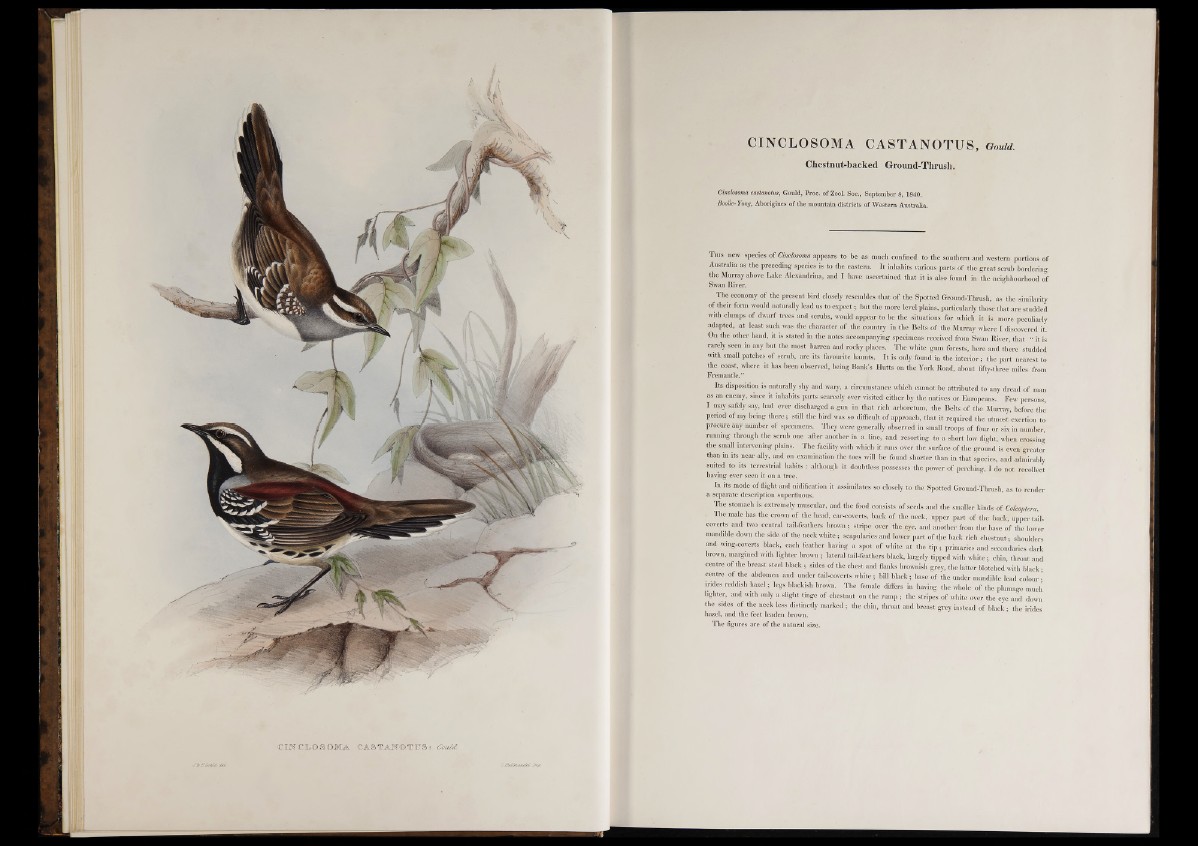
<C IH C JL .0 g .OM A C A S T A N ' O T P S : GouM.
C //ulùna mùc fntp.
CINCLOSOMA CASTANOTUS, Gouid.
Chestnut-backed Ground-Thrush.
Cinclosoma castanotus, Gould, Proc. of Zool. Soc., September 8, 1840.
Boone- Yung, Aborigines of the mountain districts of Western Australia.
T h i s new species of C m clo som a appearsgi be a s much confined to the southern and western portions of
Australia as the preceding species is to the eastern. It inhabits various parts of the great scrub bordering
the Murray ahove Lake Alexandrina, and I have ascertained that it is also found in the neighbourhood of
Swan River.
The economy of the present bird closely resembles that of the Spotted Ground-Thrush, as the similarity
o f their form would naturally lead us to expect ; hut the more level plains, particularly those that are studded
with clumps o f dwarf trees and scrubs, would appear to be the situations for which it is more peculiarly
adapted, at least such was the character of the country in the Belts of the Murray where I discovered it.
On the other hand, it is stated in the notes accompanying specimens received from Swan River, that “ it is
rarely seen in any hut the most barren and rocky places. The white gum forests, here and there studded
with small patches of scrub, are its favourite haunts. It is only found in the interior ; the part nearest to
the coast, where it has been observed, being Bank’s Hutts on the York Road, about fifty-three miles from
Fremantle.”
Its disposition is naturally shy and wary, a circumstance which cannot he attributed to any dread o f man
as an enemy, since it inhabits parts scarcely ever visited either by the natives or Europeans. Few persons,
I may safely say, had ever discharged a gun in that rich arboretum, the Belts o f the Murray, before thé
period of my being there; still the bird was so difficult o f approach, that it required'the utmost exertion to
procure any number of specimens. They were generally observed in small troops of four or six in number,
running through the scruh one after another in a line, and resorting to a short low flight, when crossing
the small intervening plains. The facility with which it runs over the surface of the ground is even greater
than in its near ally, and on examination the toes will be found shorter than in that species, and' admirably
suited to its terrestrial habits : although it doubtless possesses the power of perching, I do not recollect
having ever seen it on a tree.
In its mode of flight and nidification it assimilates so closely to the Spotted Ground-Thrush, as: to render
a separate description superfluous.
The stomach is extremely muscular, and the food consists o f seeds and the smaller kinds of C o k a p te ra .
. The male has the crown of the head, ear-coverts, back o f the neck, upper part of the back, upper tail-
coverts and two central tail-feathers brown ; stripe over the^ye, and another from the base o f the lower
mandible down the side of the neck white ; scapnlaries and lower part o f tjie back rich chestnut ; shoulders
and wing-coverts black, each feather having a spot of white at the tip ; primaries and secondaries dark
brown, margined with lighter brown ; lateral taU-feathers black, largely tipped with white ; chin, throat and
centre of the breast steel black ; sides of the chest and flanks brownish grey, the latter blotched with black ;
centre of the abdomen dud under tail-coverts white bill black ; base of the under mandible lead colour •
irides reddish hazel ; legs blackish brown. The female differs in having the whole o f the plumage much
lighter, and with only a slight tinge of chestnut on the rump ; the stripes of white over the eye and down
the sides of the neck less distinctly marked ; the chin, throat and breast grey instead of black ; the irides
hazel, and the feet leaden brown.
The figures are of the natural size.